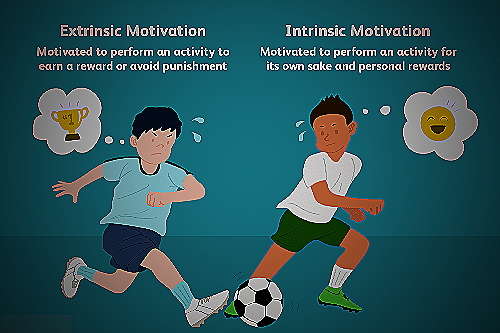Intrinsic and Extrinsic Motivation: Boosting Employee Engagement
Employee engagement is crucial to achieve a high-performing organization, and intrinsic and extrinsic motivation are critical factors in determining the level of engagement. Intrinsic and extrinsic motivation both play major roles in driving employee behavior, satisfaction, and performance, and understanding how to effectively cultivate these types of motivation can result in greater levels of engagement and a stronger commitment to the organization’s goals and values.
Are you curious about the difference between intrinsic and extrinsic motivation? Check out this Youtube video: “Extrinsic vs Intrinsic Motivation” and discover how understanding these concepts can improve your employee engagement and productivity.
If you’re struggling with motivating your team or need some inspiration to enhance your own motivation, this video is a must-watch. Don’t miss out on valuable insights that can help you manage employment problems and increase your financial success.
What Is Extrinsic Motivation?
Extrinsic motivation is a type of motivation that comes from external sources. It refers to the drive to perform a specific activity or task in order to receive a reward or avoid punishment.
Examples of extrinsic motivation include working for monetary rewards, performing well to receive praise or approval, or participating in competitions to win a prize. This type of motivation is often associated with tangible benefits and is typically a short-term motivator.
What Is Intrinsic Motivation?
Intrinsic motivation is the innate drive that comes from within an individual to accomplish a task or achieve a goal. It is the self-motivation that arises out of personal satisfaction and fulfillment in engaging in an activity that is enjoyable, interesting, or challenging.
Intrinsic motivation is the performing of an action because of the pleasure and satisfaction derived from the action itself, with little concern for an external reward or consequence.

Examples of intrinsic motivation include pursuing a hobby, reading for pleasure, solving a puzzle for the challenge, or working on a personal project. Intrinsic motivation is closely related to employee engagement, as a sense of purpose and belonging to an organization can lead to an increase in providing work with meaning and fulfillment.
Intrinsic and Extrinsic Motivation in the Workplace
Employee motivation is essential for businesses to achieve maximum productivity and efficiency. Motivation can be classified into two types – intrinsic and extrinsic motivation.
Intrinsic motivation refers to the drive that comes from within an individual. It is the willingness to perform an activity because of the satisfaction and pleasure derived from it.
Extrinsic motivation, on the other hand, is when external factors like rewards, recognition, and praise drive an individual’s behavior.
Benefits and Drawbacks of Intrinsic Motivation
Intrinsic motivation is considered the ideal form of motivation as it arises naturally and promotes an individual’s well-being. Research suggests that intrinsically motivated employees have higher creativity, productivity, and job satisfaction compared to those who are extrinsically motivated.
However, intrinsic motivation has some drawbacks. It may not be sufficient for individuals performing tedious or repetitive tasks.
Additionally, intrinsic motivation may not be enough to compensate for inadequate compensation or a toxic work environment.
Benefits and Drawbacks of Extrinsic Motivation
Extrinsic motivation can be an effective tool for driving performance in employees. By providing rewards and incentives, organizations can encourage their employees to perform at their best.
It can lead to increased productivity, engagement, and loyalty.
However, extrinsic motivation has its drawbacks. Employees who are too dependent on rewards might lose their intrinsic desire to work and become less creative and innovative.
Moreover, rewards and recognition systems can be counterproductive if not implemented strategically.
How to Utilize Intrinsic and Extrinsic Motivation in the Workplace
The key to effective employee motivation is to balance the benefits of intrinsic and extrinsic motivation. Employers must create a work environment that fosters intrinsic motivation by providing employees with autonomy, opportunities for mastery, and a sense of purpose.
At the same time, employers should also utilize extrinsic motivators, such as rewards, recognition, and career advancement opportunities, to encourage employee performance.
It is essential to note that the utilization of intrinsic and extrinsic motivation varies depending on the nature of the employee’s responsibilities and the organization’s goals. Employers must assess their organization’s objectives and tailor the motivational strategies accordingly.
Boosting Employee Engagement with Intrinsic and Extrinsic Motivation
Employee engagement is crucial for an organization’s success, and intrinsic and extrinsic motivation can play a major role in improving engagement. Intrinsic motivation comes from within oneself and includes feelings of personal satisfaction and fulfillment while performing a job.
Extrinsic motivation, in comparison, comes from external factors like rewards, praise, and promotions. While both types of motivation are important, research has shown that intrinsic motivation is a stronger predictor of employee engagement.
It is essential for organizations to strike a balance between intrinsic and extrinsic motivation to improve employee engagement. While incentives like bonuses and promotions can be effective, it is important not to solely rely on them.
Focusing on intrinsic factors such as meaningful work, autonomy, and opportunities for personal growth and development can also increase engagement and motivation. In addition, providing regular feedback and recognition to employees can help boost both intrinsic and extrinsic motivation.
Organizations can also implement team building activities to improve engagement and foster a positive work culture. Activities such as group outings, community service projects, and peer recognition programs can foster camaraderie and a sense of belonging within the organization.

When to Use Extrinsic Motivation
Extrinsic motivation can be effective in certain situations, such as when trying to encourage employees to complete a specific task or achieve a particular goal that they may not feel inherently motivated to do. For example, offering a bonus or promotion for reaching a sales target may incentivize employees to work harder and boost productivity.
However, it is important to avoid becoming too reliant on extrinsic motivation, as this can lead to employees only being motivated by external rewards and punishments, rather than finding satisfaction in their work. Extrinsic motivation should be used sparingly and balanced with intrinsic motivation, which comes from within and involves finding pleasure and meaning in the work itself.
It is also important to note that extrinsic motivation may not be effective for all individuals and that value-based benefits, such as providing opportunities for learning and growth, may be more motivating for some employees.
How Do Intrinsic Motivation and Extrinsic Motivation Influence Learning?
In today’s fast-paced work environment, continuous learning is essential for individuals to remain competitive and succeed in their careers. Understanding what motivates employees to learn is crucial in designing effective learning programs that maximize employee engagement and satisfaction.
Intrinsic Motivation and Learning
Research has shown that intrinsic motivation is a critical factor in employee learning and development. When employees are intrinsically motivated to learn, they are more likely to stay engaged and committed to the learning process, even in the face of challenges.
Intrinsic motivation is driven by factors such as personal interests, curiosity, and the desire to master a new skill. When individuals are motivated by intrinsic factors, they are more likely to invest time and effort into learning, even if there is no immediate external reward.
Organizations can foster intrinsic motivation by providing opportunities for employees to pursue their interests and explore new areas of learning. For example, offering self-directed learning programs and giving employees autonomy to choose their learning goals and methods can help promote intrinsic motivation.
Extrinsic Motivation and Learning
While intrinsic motivation is a powerful driver of learning, extrinsic motivation can also play a role in motivating employees. Extrinsic motivation is driven by external factors such as rewards, recognition, and competition.
Extrinsic rewards can be an effective way to motivate employees to learn, especially when the rewards are closely linked to the learning objectives. For example, offering promotions, bonuses, or professional development opportunities in exchange for completing a training program can be a powerful motivator.
However, extrinsic rewards can also have negative effects on motivation if they are perceived as unfair, insufficient, or controlling. In some cases, external rewards can even undermine intrinsic motivation by shifting the focus from the joy of learning to the pursuit of the reward.
Enhancing Learning Through Motivation
To maximize employee engagement and learning, organizations should strive to create a balance between intrinsic and extrinsic motivation. Providing opportunities for self-directed learning and personal growth can help foster intrinsic motivation, while offering rewards and recognition for accomplishments can help boost extrinsic motivation.
Effective learning programs should also take into account individual differences in motivation. Some employees may be more motivated by intrinsic factors, while others may respond better to extrinsic rewards.
By designing programs that take into account individual needs and preferences, organizations can help ensure that all employees are engaged and motivated to learn.
Case Studies of Successful Intrinsic and Extrinsic Motivation Implementation
Employee engagement and motivation are vital factors for the success of any organization. Companies that focus on combining intrinsic and extrinsic motivation have been able to keep their employees engaged and motivated, resulting in increased productivity and job satisfaction.
Here are some examples of companies that have effectively utilized a combination of intrinsic and extrinsic motivation to engage employees:
The Coca-Cola Company
The Coca-Cola Company offers a variety of intrinsic and extrinsic rewards to keep their employees motivated. They offer career development opportunities, health and wellness programs, and competitive salaries to keep their employees engaged and motivated.
Employees are also recognized and rewarded for exceptional job performance.
DreamWorks Animation
DreamWorks Animation encourages creativity and innovation, which serves as intrinsic motivation for employees. They also offer extrinsic rewards such as cash bonuses and stock options to keep their employees motivated.
Employee recognition programs are also in place to acknowledge outstanding job performance.
Google & Facebook
Google and Facebook are known for their unique work environments that promote creativity and individuality. They also offer competitive salaries, employee perks, and stock options to keep their employees motivated.
Employees are also given opportunities to participate in personal projects and given autonomy in their work, which creates intrinsic motivation and job satisfaction.
L’Oreal
L’Oreal provides its employees with a collaborative work environment and opportunities for career development, which serves as intrinsic motivation. Employees are also given bonuses and other financial incentives for meeting performance goals and targets, which serve as extrinsic motivation.
Virgin
Virgin creates a positive work culture by providing its employees with unique benefits such as unlimited vacation days and work from home opportunities. They also offer financial incentives and employee recognition programs to keep their employees motivated.
These companies have been successful in combining intrinsic and extrinsic motivation to engage their employees and increase productivity. By understanding what motivates their employees, these companies have been able to create a positive work culture and reduce turnover rates.
Conclusion
Intrinsic and extrinsic motivation play integral roles in promoting engagement among employees in an organization. Team building activities can help foster a positive culture that can lead to greater intrinsic motivation.
However, different people will respond differently to extrinsic motivation, and it is important to acknowledge this and offer value-based benefits. Ultimately, an understanding of motivation can help improve employee productivity and satisfaction, and organizations can motivate employees at every stage of their life cycle to achieve success.

